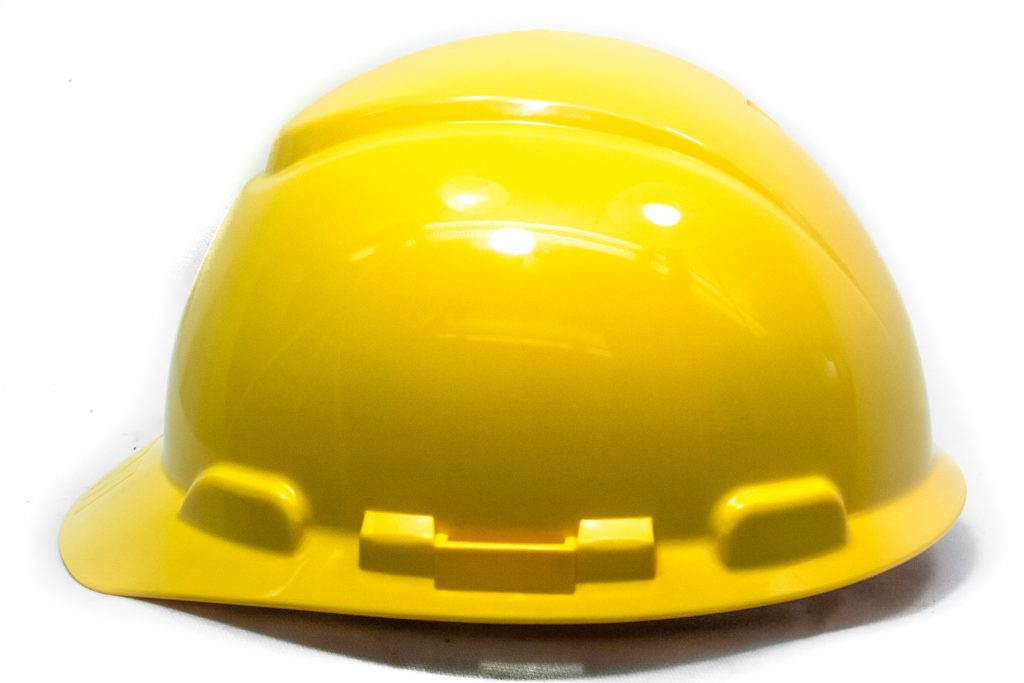1.4 Head Protection
Head Protection
Protecting employees from potential head injuries is a key element of any safety program. A head injury can impair an employee for life or it can be fatal. Wearing a safety helmet or hard hat is one of the easiest ways to protect an employee’s head from injury. Hard hats can protect employees from impact and penetration hazards as well as from electrical shock and burn hazards.
Employers must ensure that their employees wear head protection if any of the following apply:
- Objects might fall from above and strike them on the head;
- They might bump their heads against fixed objects, such as exposed pipes or beams; or
- There is a possibility of accidental head contact with electrical hazards.
Some examples of occupations in which employees should be required to wear head protection include construction workers, carpenters, electricians, linemen, plumbers and pipefitters, timber and log cutters, welders, among many others. Whenever there is a danger of objects falling from above, such as working below others who are using tools or working under a conveyor belt, head protection must be worn. Hard hats must be worn with the bill forward to protect employees properly.
In general, protective helmets or hard hats should do the following:
- Resist penetration by objects.
- Absorb the shock of a blow.
- Be water-resistant and slow burning.
- Have clear instructions explaining proper adjustment and replacement of the suspension and headband.
Hard hats must have a hard outer shell and a shock-absorbing lining that incorporates a headband and straps that suspend the shell from 1 to 1 1/4 inches (2.54 cm to 3.18 cm) away from the head. This type of design provides shock absorption during anti-impact and ventilation during normal wear.
Protective headgear must meet ANSI Standard Z89.1-1986 (Protective Headgear for Industrial Workers) or provide an equivalent level of protection. Helmets purchased before July 5, 1994 must comply with the earlier ANSI Standard (Z89.1-1969) or provide equivalent protection.
Bump Hats vs. Hard Hats

Hard Hat by Rita Wheeler is licensed under CC BY 4.0
There are two common classes of protective headgear known as “bump hats” and “hard hats”. Bump Hats are designed for use in areas with low head clearance and are recommended for areas where protection is needed from head bumps and lacerations. When the risk of falling or flying objects are present then an ANSI approved Hard Hat is required instead.
There are many types of hard hats available in the marketplace today and it is essential to check the type of hard hat employees are using. Each hat should bear a label inside the shell that lists the manufacturer, the ANSI designation and the class of the hat. This information should be compared against working conditions to ensure proper protection against potential workplace hazards with a requirement for employees to wear the hard hat at all times. It is important for employers to understand all potential hazards when making this selection, including electrical hazards. This can be done through a comprehensive hazard analysis and an awareness of the different types of protective headgear available.
Hard hats are divided into three industrial classes:
Class A hard hats provide impact and penetration resistance along with limited voltage protection (up to 2,200 volts).
Class B hard hats provide the highest level of protection against electrical hazards, with high-voltage shock and burn protection (up to 20,000 volts). They also provide protection from impact and penetration hazards by flying/falling objects.
Class C hard hats provide lightweight comfort and impact protection but offer no protection from electrical hazards.
Size and Care Considerations
Head protection that is either too large or too small is inappropriate for use, even if it meets all other requirements. Protective headgear must fit appropriately on the body and for the head size of each individual. Most protective headgear comes in a variety of sizes with adjustable headbands to ensure a proper fit (many adjust in 1/8-inch increments). A proper fit should allow sufficient clearance between the shell and the suspension system for ventilation and distribution of an impact. The hat should not bind, slip, fall off or irritate the skin.
Some protective headgear allows for the use of various accessories to help employees deal with changing environmental conditions, such as slots for earmuffs, safety glasses, face shields and mounted lights. Optional brims may provide additional protection from the sun and some hats have channels that guide rainwater away from the face. Protective headgear accessories must not compromise the safety elements of the equipment.
Periodic cleaning and inspection will extend the useful life of protective headgear. A daily inspection of the hard hat shell, suspension system and other accessories for holes, cracks, tears or other damage that might compromise the protective value of the hat is essential. Paints, paint thinners and some cleaning agents can weaken the shells of hard hats and may eliminate electrical resistance. Consult the helmet manufacturer for information on the effects of paint and cleaning materials on their hard hats. Never drill holes, paint or apply labels to protective headgear as this may reduce the integrity of the protection. Do not store protective headgear in direct sunlight, such as on the rear window shelf of a car, since sunlight and extreme heat can damage them.
Hard hats with any of the following defects should be removed from service and replaced:
- Perforation, cracking, or deformity of the brim or shell;
- Indication of exposure of the brim or shell to heat, chemicals or ultraviolet light and other radiation (in addition to a loss of surface gloss, such signs include chalking or flaking).
Always replace a hard hat if it sustains an impact, even if damage is not noticeable. Suspension systems are offered as replacement parts and should be replaced when damaged or when excessive wear is noticed. It is not necessary to replace the entire hard hat when deterioration or tears of the suspension systems are noticed.
